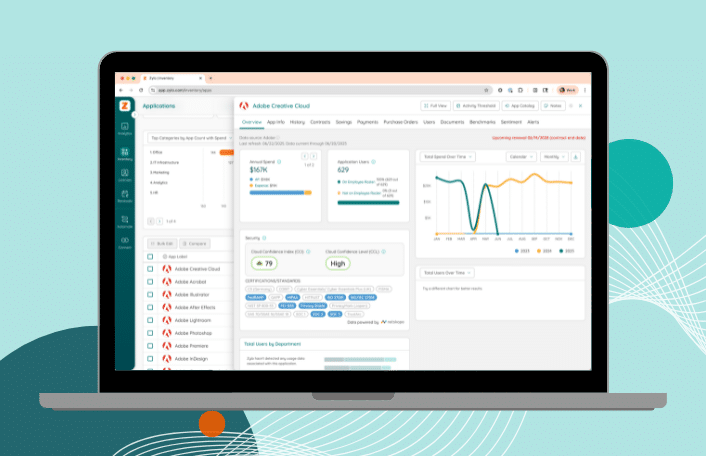
From Chaos to Control: Applying FinOps Thinking to SaaS
Table of Contents ToggleWhat Generative AI Programs Are Being Used?ChatGPTGoogle BardOpenAI...
Back
Back
Search for Keywords...
Blog

Table of Contents
Have you watched the news lately? If so, you’ve probably heard a lot about generative artificial intelligence (AI) in recent months. AI has received a lot of press attention, both about the potential risks it could pose and its potential uses.
No matter how you personally feel about AI, the reality is that it’s here to stay. And there are a lot of ways it can help your business from more personalized user experiences, content creation, product enhancement, and more.
There are also personal benefits to using AI. Namely, gains in time, efficiency, and productivity. Ultimately, AI gives you more time for strategic work and innovation. To get started using AI for SaaS management, we put together a list of use cases.
Before we jump into the SaaS Management use cases for AI, let’s take a look at the tools being used. Today, several different generative AI programs exist on the web, with more currently in development. Each of these unique programs has tasks that they tend to best be suited for and all of them are still currently being tested and updated.
Let’s take a look at some of the most popular AI programs that are available online, as well as the features that they offer.
ChatGPT is probably the most well-known of all of the current AI technologies and is quite useful for a variety of different purposes. ChatGPT was developed and is operated by OpenAI and can generate human-like text to aid users in writing or understanding a topic. It can also be used for tasks such as:
Another powerful AI option that works similarly to ChatGPT by providing text-based responses to users is Google Bard. Google Bard is formatted more toward search queries than ChatGPT. It’s also designed to only be compatible with Google technology, which can create some limits around its use. However, the information that it provides is based on real-time data, whereas ChatGPT’s info is from 2021.
OpenAI Playground is another text-based language model in development by the same creators as ChatGPT. It’s currently in the beta-testing phases, so it isn’t available to the general public, though you can sign up for a trial. OpenAI offers some more advanced customization and tailoring features than ChatGPT but utilizes the same neural network. It’s great for text generation and language translation, as well as generating conversational text.
Bing Chat also utilizes the OpenAI model to power itself and is now built right into Bing’s search engine. Users can type in queries and the language-based model will respond with search results, as well as links and citations. The entire experience is formatted in a conversational tone, similar to the other chatbots listed above.
Thanks to powerful models like these, AI is now mainstream! Its newfound popularity also means that new AI use cases are being discovered every day. The advanced technology and automation that AI uses can have a large impact on how your business operates, allowing you to streamline your day-to-day operations and increase productivity levels.
If you take any part in managing SaaS, you know there’s a lot of work to be done. And only so many hours in the day. Here are four AI use cases that demonstrate the positive impact on your work day:
No one likes scrolling through long legal documents with lots of complicated jargon. These documents can also be quite difficult to understand, so being able to summarize their key points can be a huge time-saver. In addition, clickthrough agreements (online agreements that you agree to by clicking a button or checking a box) are not always particularly favorably written in regard to the purchaser.
AI can help summarize these complicated legal agreements, helping you better understand their main points and ensuring your business is not agreeing to anything objectionable. It can also help prevent unforeseen costs by providing you with additional transparency.
Using AI to understand how two applications stack up against each other is a great way to foster conversations about new technologies. Compare things like features, pricing models, and more. It’s particularly useful for those in IT and procurement, who may not understand the intricacies of the tools – for instance, marketing or finance technologies. However you ultimately decide to use them, this use case is quite valuable for application rationalization decisions.
Language-model AI is also an extremely helpful tool for writing communications. Drafting vendor communications can be tricky, so utilizing a chatbot to help write the first draft can save you time and effort.
There are numerous reasons why you may need to reach out to your SaaS vendor or provider. Here are a few types of emails you should consider writing with AI:
Many SaaS applications have different features and products that are optimized for certain uses, as well as varying pricing models. These complexities can make it difficult to understand what application will work best for your organization.
Keeping track of all of this information is key to making an informed decision for your business. However, researching can also be difficult and draining. SaaS managers can use AI in this scenario to examine SaaS applications, so they’re able to select the best one for their business. A chatbot can also assist you with researching them and helping you compare and contrast each one.
What have your experiences been with AI so far? How are you using it to boost productivity and efficiency among your SaaS management efforts? Reach out to me on LinkedIn and share your experiences! I’ll keep updating this blog as this technology continues to advance, so stay tuned for more.
ABOUT THE AUTHOR

Ben Pippenger
Ben is responsible for shaping and driving Zylo’s corporate strategy by monitoring and analyzing key market trends. As Zylo co-founder, he is passionate about the power of SaaS and helping organizations understand how they can manage, measure and maximize their investments for greater business impact. Ben is a self-proclaimed SaaS geek, with more than 20 years of B2B software experience, and a recognized SaaS and software management thought leader. Before founding Zylo, Ben held leadership roles in product and account management at Salesforce and ExactTarget.

Table of Contents ToggleWhat Generative AI Programs Are Being Used?ChatGPTGoogle BardOpenAI...

Table of Contents ToggleWhy Data Integrity Breaks DownWhat Does Data Integrity...

Table of Contents ToggleWhat Generative AI Programs Are Being Used?ChatGPTGoogle BardOpenAI...

Table of Contents ToggleShelfware DefinedWhy Shelfware HappensPoor Organizational OversightShadow IT and...
| Cookie | Duration | Description |
|---|---|---|
| cookielawinfo-checkbox-analytics | 11 months | This cookie is set by GDPR Cookie Consent plugin. The cookie is used to store the user consent for the cookies in the category "Analytics". |
| cookielawinfo-checkbox-functional | 11 months | The cookie is set by GDPR cookie consent to record the user consent for the cookies in the category "Functional". |
| cookielawinfo-checkbox-necessary | 11 months | This cookie is set by GDPR Cookie Consent plugin. The cookies is used to store the user consent for the cookies in the category "Necessary". |
| cookielawinfo-checkbox-others | 11 months | This cookie is set by GDPR Cookie Consent plugin. The cookie is used to store the user consent for the cookies in the category "Other. |
| cookielawinfo-checkbox-performance | 11 months | This cookie is set by GDPR Cookie Consent plugin. The cookie is used to store the user consent for the cookies in the category "Performance". |
| viewed_cookie_policy | 11 months | The cookie is set by the GDPR Cookie Consent plugin and is used to store whether or not user has consented to the use of cookies. It does not store any personal data. |
